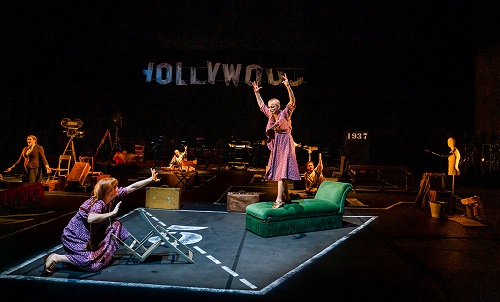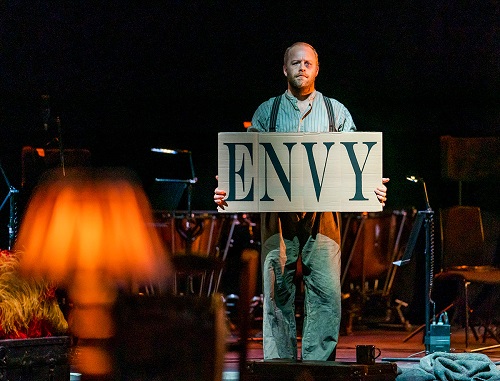Kurt Weill’s ballet chanté, Die sieben Todsünden (The Seven Deadly Sins), is a work of exile in troubled times, Weill and Brecht wrote it in 1933 in Paris shortly after the two had fled Nazi persecution in Germany. With its satirical view of life and up turning of moral values, it is perhaps a profoundly appropriate work.
Opera North was planning a production of the work in English, as The Seven Deadly Sins, as part of its live season at Leeds Playhouse. Fate had other ideas, and the performance became a live stream on Saturday 21st November 2020. The work was directed and choreographed by the British choreographer Gary Clarke, with Wallis Giunta and Shelley Eva Haden as Anna I and Anna II, Stuart Laing and Nicholas Butterfield as the Brothers, Campbell Russell as the Father and Dean Robinson as the Mother. James Holmes conducted members of the orchestra of Opera North in HK Gruber and Christian Muthspiel’s new arrangement for 15 players. The work was sung in Michael Feingold’s English translation.
The work to some extent mirrors the travails of its creators and the sense of exile, whilst Weill had fled directly to Paris (where he had supporters and contacts), Brecht’s had been a long journey through seven different countries before he settled in Switzerland. And the strange split-personality heroine was also the result of real life. The commissioner, Edward James, who wanted it for his new ballet company, viewed the ballet as a means of reconciliation with his dancer-wife, Tilly Losch. The fact that Losch resembled Weill’s wife Lotte Lenya led to the specification of the double, so the dancer in the work would have to be Losch. Brecht and Weill’s partnership had ceased in 1930 thanks to politics and this final collaboration was itself the result of the disruptions of exile.
The work is quite dark, despite the vividness of Weill’s music and the way he incorporates popular dance movements. Clarke’s production emphasised this darkness and referenced the work’s origins in the events of 1933. The family are themselves exiles, and are homeless at the beginning of the opera, whilst the various scenes for the two Annas referenced a wide variety of 1930s films and cabaret. Clarke’s choreography for Shelley Eva Haden was almost constant, not just in the dance sequences but as a counterpoint to Wallis Giunta’s solos. The result was somewhat tiring to the eye, but this might have been the way the camera was drawn to Haden’s dancing in a way that would not have happened if we had been watching live.

The set, designed by George Johnson-Leigh, was a sequence of small film stages, each one highlighting a different film reference in the production and the two Annas moved around them. Behind them was the orchestra, and behind it the family, setting up their new home from nothing. Here we come to one of the limitations of the live stream, as some of the detail was lost, when the family was not singing their activity receded into the background whereas in the theatre, audiences would have been able to take in the totality of the experience.
By the end of the opera, we have come to understand that Shelley Eva Haden’s Anna has worked herself into a total breakdown, and the whole performance was a bravura one from Haden. Wallis Giunta sang the role of Anna at the original pitch, rather than the one a fourth lower created for Lotte Lenya after the war (Lenya’s wish to revive her late husband’s works with Brecht in 1950s America required her to undertake wholesale transposition to suit the state of her voice at the time). Giunta brilliantly captured Anna’s smart manner and steely underside. As intended, she was hardly a sympathetic character yet Giunta imbued her with a finely musical performance.

Stuart Laing, Nicholas Butterfield, Campbell Russell and Dean Robinson provided strong support as the family, altering the musical textures with their strong four-part male, neo-Barbershop singing and a serious, pointed edge to their performance.
Michael Feingold’s translation is apt and singable, but I did rather miss some of the felicitous phrasing from the traditional Chester Kalman and WH Auden translation.
HK Gruber and Christian Muthspiel’s new orchestration, made for a planned production at the Royal Opera House in Spring 2021, keeps the work’s spice and edge whilst bringing a new clarity to the score with the reduction to 15 performers. For all the work’s origins as a sort of cabaret ballet, the music in it includes recycled elements from Weill’s symphonic works and Gruber and Muthspiel’s reduction brilliantly massages everything down to 14 instruments without too much loss. James Holmes conducted with some point, the bouncy dance numbers all had an edge to them, so that the whole piece felt the right mix of fun and danger. Dancing on the edge of the volcano indeed.
The original intention of the commission was not fulfilled, Edward James was not reconciled with Tilly Losch. But Kurt Weill was reconciled with Lotte Lenya, the two having split whilst in Germany, and they would travel to the USA together. But that is another story, and a different musical style.
Robert Hugill
Kurt Weill, Bertholt Brecht: The Seven Deadly Sins
Anna – Wallis Giunta/Shelley Eva Haden, The Family – Stuart Laing, Nicholas Butterfield, Campbell Russell and Dean Robinson; Director/choreographer – Gary Clarke, Conductor – James Holmes, Designer – George Johnson-Leigh, Orchestra of Opera North, Opera North at Leeds Playhouse (live stream); Saturday 21st November 2020.